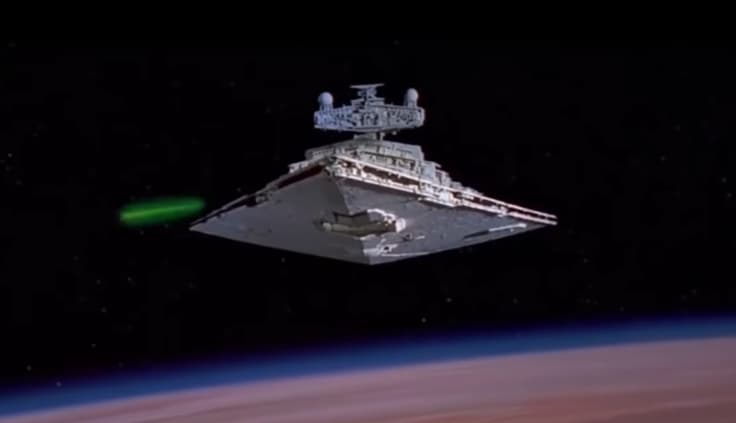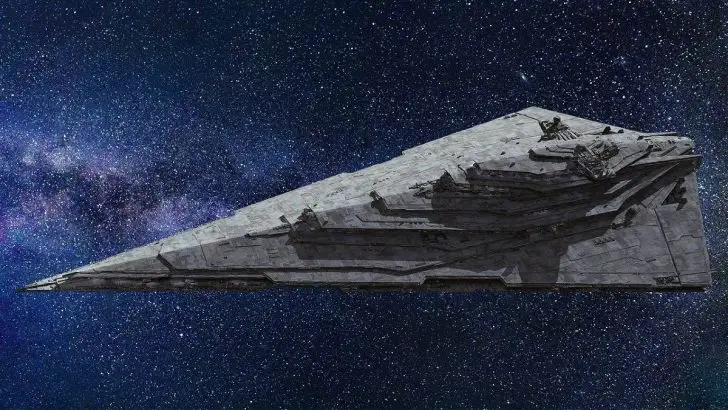If you’ve ever watched a Star Wars movie, the shape of the imperial Star Destroys might have gave you feelings a dread or fear. Some people have referred to their triangular shape as wedge-like, and my favorite, others say they are shaped like a piece of pizza. In Star Wars lore, they are often referred to as “dagger-like”.
So why are Star Destroyers triangular? Their cinematic design was modeled after WWII battleships combined with aerodynamic shapes, but has no relation to real world physics.
In lore, Star Destroyers are designed after the Sith dreadnoughts of the Old Empire, a category of ships known asHarrowers.
Even though the design of Star Destroyers doesn’t reflect how physics actual work in a zero-gravity environment or real life, their dagger-like shape has become an iconic image of the Star Wars franchise.
Read on to find out more about Star Destroyers iand why they look the way they do.
Star Destroyers Are Modeled After the Delta Wing Shape
In cinema, the shape of the Star Destroyer is greatly influenced by the aerodynamic shape of a delta wing in fighter aircraft. This triangular wing shape is popular in several advanced airplanes that are designed for subsonic/supersonic flight at high speeds. The delta is named for its similarity to the triangular Greek symbol for delta.
While this shape is very aerodynamic and makes for faster airplanes in atmospheric flight physics, this design would be largely lost in effectiveness when it comes to zero-gravity flight. Since there is no atmosphere in space to account for, there isn’t a need for aerodynamic design. Even in atmospheric applications, Star Destroyers are never shown flying horizontally at high speeds.
By drawing on influence from the design of these high-tech bombers, the creators of the Star Wars movies and television shows have visually emphasized the technological superiority of the Galactic Empire. The Empire’s warfare capabilities make them a force to be reckoned with, which explains why there are so many worlds in the Star Wars lore who are Imperial collaborators.
Like the one wing design, triangular B-2 bombers, Star Destroyers are an advanced state-of-the-art spacecraft designed for maximum damage. Unlike the B-2 bombers, Star Destroyers aren’t designed for a stealth approach. The Empire didn’t care who saw them coming.
Some Star Destroyers Are Designed for Atmospheric Flight
Even though Star Destroyers spend the majority of their time in deep space, it should be noted that some Star Destroyers are capable for atmospheric flight, as is shown in several Star Wars films and television shows. Even though Star Destroyers are meant to be command ships in deep space combat, they are still often shown parking over a world during troop transport or threatening negotiations.
Even so, Star Destroyers don’t spend much time actually flying in atmospheric situations. Instead, they land to facilitate troop movements and suppliers or hover above a planet’s surface. Though the Star Destroyer seems designed for high-speed horizontal flight, in most cases a Star Destroyer is shown as hovering in mid-air if it isn’t in a hyperspace jump. This makes the Star Destroyer more like a high-offense cargo vessel than the sleek bombers and fighter jets that helped inspire its shape.
This means that even though the Star Destroyer’s design is centered around aerodynamic flight on a horizontal plane, aerodynamics rarely (if ever) play a real role in the flight of a Star Destroyer spacecraft. Star Destroyers focus on offensive and defensive capabilities with regards to firepower and protection, rather than focusing on speed, agility, and evasive maneuvers.

Star Destroyers Focus on Forward Firing Power
One theory that has arisen on the Internet is that Star Destroyers are triangular because they are focused on forward firing power. However, this design doesn’t really make sense given that in a four-dimensional space, enemy spacecraft can easily attack from any direction, including the rear.
Despite its Achilles heel to the rear, the Star Destroyer has major offensive and troop deployment capabilities in combat. Star Destroyers are equipped with 60 turbolasers turrets as well as 60 ion cannons. This kind of firepower means that Star Destroyers are rarely in a position where they have to turn tail and retreat from the battlefield.
One reason why Star Destroyers aren’t necessarily concerned about protecting their flanks is that they are often depicted as command ships in charge of a much larger Imperial fleet, meaning they are somewhat dependent on the smaller gun ships it transports to serve in its defense.
Since a Star Destroyer is not an agile craft when it comes to repositioning itself in combat, the wedge-like design of its shape offers a very wide firing arc in comparison to other designs. With a triangular design, a Star Destroyer is capable of firing in almost a 180° angle. Warships with a rounded or rectangular shape would have more of their firing power blocked by the girth of the ship itself.
Star Destroyers Are Built for Defense
Another advantage of the triangular shape of the Star Destroyer is that it provides smaller surface area for enemy ships to target. This in combination with the shield generators and heavy hull plating of a Star Destroyer means that this warship makes up for its lack of agility with armor instead.
The Star Destroyer is capable of enormous offensive capability as a direct result of its triangular design (hence the name) but the triangular shape of a Star Destroyer serves to help protect it as well. Even though it may seem to lack defense in the rear, the shield generator capability of a Star Destroyer means that it can survive a collision with another large transport ship without sustaining major damage.
Star Destroyers Are Modelled After Traditional Battleships Combined with Planes
When you watch the Star Wars films and television shows, it’s easy to see the design influences of traditional WWII battleships and high-tech planes on the design of Star Destroyers and the other spacecraft in the film.
While these designs make a lot of sense in a horizontal battleground such as the surface of the ocean or the airspace above land, these designs are more efficient for atmospheric flight than they are for anything in space. Because space is four-dimensional, it allows craft to maneuver in any direction.
Imperial Star Destroyers Are Inspired by Sith Dreadnoughts
In cinema, the designs of Star Destroyers are modeled closely after traditional ships and planes, but in the Star Wars universe, the dagger-like shape of the modern Star Destroyer is inspired by a class of Sith dreadnoughts known as harrowers. These capital ships were capable of transporting dozens of shuttles, bombers, and starfighter spacecraft to a front-lines conflict.
In Star Wars lore Sith and Imperial battlecruisers are often referred to as having a “dagger-like” shape, and it seems that in Star Wars lore the dagger or Shikkar holds a lot of symbolic value for the Sith culture. This is because the Sith culture places a strong emphasis on ascension through the Sith hierarchy as a result of violent assassination.
The shape of a Star Destroyer might not be the most realistic given the physics required of a spacecraft that can theoretically move in all directions, but symbolically the shape of an Imperial Star Destroyer evokes danger and
Whether you look at the Star Wars lore or the visual inspirations behind the Star Wars cinematic concepts, there are many reasons why Star Destroyers have a triangular shape. No matter what shape they are, nobody can deny how intimidating and dangerous these battle cruisers look while travelling in the galaxy.
Sources:
- https://starwars.fandom.com/wiki/Imperial_I-class_Star_Destroyer
- https://news.usni.org/2014/04/28/midwest-mystery-jets-actually-b-2-stealth-bombers
- https://starwars.fandom.com/wiki/Harrower-class_dreadnought





Leave a comment
You must be logged in to post a comment.